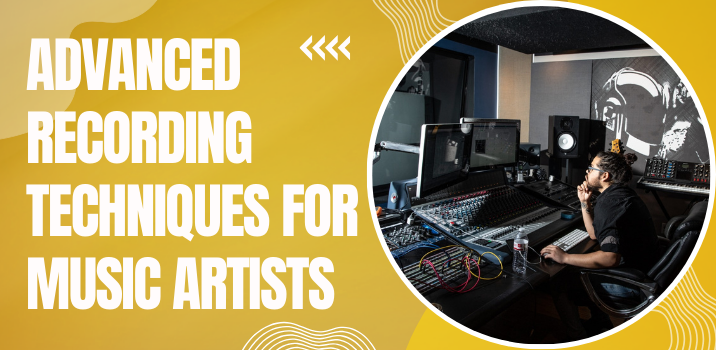Advanced Recording Techniques for music artists

17-May-2024
Advanced Recording Techniques for Music Artists The music industry is always changing and the approach to music creation, the recording of music has become advanced, and this is the instrument that artists who are looking for musical perfection are using. It is not only the fact that these techniques widened the scope of creativity that is the main reason for their impact, but also the way music is recorded and heard has been completely changed since their invention.
Here are some advanced recording techniques that music artists can explore:
. Multi-Microphone Techniques Numerous microphones are used in multi-microphone techniques to record various aspects of a sound source. This mode is usually applied when recording live performances, orchestras, and drum kits. You can better control the mixing process, capture the finer details of each instrument, and produce a more engaging sound by coordination microphones at different angles.
. Stereo Miking Techniques Using two microphones to collect a sound source in a way that closely resembles how human ears perceive sound is known as stereo miking. The resulting stereo image is wider and more accurate. Typical methods for stereo miking include:
- X/Y Configuration: To capture a coordinated stereo image, two microphones are arranged closely together at a 90-degree angle.
- ORTF Configuration: To create a realistic stereo effect, two microphones are located at a 110-degree angle and 17 cm apart. This imitates the distance between human ears.
. Close and Distant Miking Setting up two microphones one near the sound source and the other a little further away—is known as close and distant miking. While the distant mic captures the sonic textures and natural reverb of the room, the close mic clearly captures direct sound. By using this method, you can merge the best signals to create a sound that is more expensive and richer. This solution operates notably well with recording vocals, guitars, and pianos.
. Room Mic Placement Simply putting room microphones correctly is essential to capturing a recording space's authentic soundscape. Strategically placing microphones across the the space allows you to record reflections and resonances, giving the audio more depth and uniqueness. To blend the direct sound with the ambience of the room and produce a richer overall texture, room mics are frequently used in connection with close mics.
. Using Ambisonics Microphone The ambisonics microphones help you to hear audio in all directions, thus, you can enjoy the 360-degrees experience. This technique is favorable particularly for VR immersive audio environments and 3D audio applications. With unmatched flexibility and realism, ambisonics recordings can be accurate within a 3D space through post-production handling.
. Blumlein Pair Technique The Blumlein Pair technique employs two 8-shaped microphones that are located at a right angle to each other thus capturing the sound from all directions and at the same time preserving its natural phase coherence. This method gives off an extremely realistic stereo image and is perfect for recording ensembles, choirs, and acoustic instruments in a well-balanced acoustic environment. The Blumlein Pair is famous for its skill in capturing three-dimensional and spatial details.
. The technique of Mid-Side (MS) Recording is a unique method of capturing images that involves the mid-shots and the side-shots being recorded simultaneously. The Mid-Side (MS) recording technique involves using two microphones: One cardioid (mid) microphone facing the sound source and one figure-8 (side) microphone stationed at a right angle to the mid mic. The mid microphone is the one which is in the center and captures the sound, which is of the primary importance, on the other hand, the side microphone records the background sounds and spatial information. In the post-production phase, the side signal is divided into two channels and reversed to produce a stereo image. This method emits the precise control of the width and depth of the stereo field; hence, it is very adaptable for different recording situations.
Conclusion:
Advanced recording techniques give music artists the means to reach the new height of their sound, thus the process of recording becomes more controlled, deeper, and creative. Using these techniques, the artist can represent the subtleties and the details of his performance, thus, creating music that is very moved by the listeners.
If you are looking for a recording studio in Los Angeles where the environment is more like a creative hub than just a place to record, UNION Recording Studio is the first place that you should choose. UNION provides a special place where creativity and innovation are supported, having the most modern technology and the best professionals ready to assist you in the realization of your musical dream.
Secure today your lesson at UNION Recording Studio and your music will be in a place of creativity.